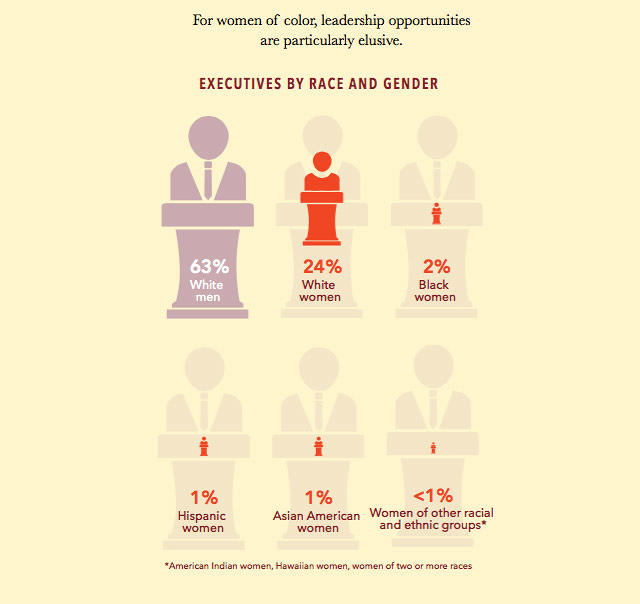Why The Gender management gap Is a lot Worse for girls Of coloration
“From corporate boardrooms to the halls of Congress, from universities to the courts, from non secular establishments to philanthropic businesses, men are simply more likely than ladies to be leaders.” This, in line with a new file from the American affiliation of university women (AAUW).
This is not news to somebody who has been paying attention, but this new find out about does bring the persistence and complexity of such underrepresentation into more center of attention.
The file, titled “limitations and Bias: The standing of ladies in management,” examines the setting where management develops and was once written by AAUW vp for analysis Catherine Hill; senior researcher Kevin Miller; analysis associate Kathleen Benson; and analysis intern Grace Handley. They contend that no amount of leaning in can close the systemic gender gap in the top ranks of companies. that’s partly as a result of components such as race and ethnicity, socioeconomic status, disability status, sexual orientation, gender identity, and age make for distinctive experiences for any women who tries to upward push to leadership.
“There need to be one thing inherent in the machine that’s working against them,” the authors write, as a result of we all know that this isn’t a pipeline downside. There are more ladies working as of late than ever sooner than (fifty five% of the total global staff). women earn the vast majority of college levels in keeping with data from Census reports. And each men and women rating in a similar fashion of their capacity to pressure trade, in line with a study by DDI.
yet female leadership numbers remain dismal. in line with Catalyst only 5% of companies in usual and terrible’s 500 had ladies CEOs in 2015. identical disparities occur within the nonprofit sector, executive, unions, spiritual institutions, and academia. “Subtler problems like hostile work environments, poor stereotypes about women in leadership, and bias additionally keep girls out of the top spots,” they write, “Unconscious or implicit bias can cloud judgment in methods people are now not fully aware of.”
for girls of coloration, this hole is even wider. Fewer than three% of board administrators at Fortune 500 companies are Asian, black, and Hispanic girls, in step with the Catalyst report. These minority groups of ladies make up 17% of workers in S&P 500 companies but fewer than four% of govt officers and managers. while knowledge about lesbian, homosexual, bisexual, and transgender (LGBT) ladies leaders isn’t with ease to be had, the document’s authors cite a up to date learn about that exposed girls who identified as LGBT on their resumes got 30% fewer callbacks than different women.
The Underlying downside
The document’s authors level out that gender, race, and age are ceaselessly subject to stereotyping. Even positive stereotypes can hurt, such as when a man doesn’t show off the everyday aggression often assigned to male management. On the flip aspect, ladies are assumed to be caregivers and therefore given an armload of “housekeeping” duties in the place of business —even by way of different women. Then, the harm is finished. “once a stereotype has been adopted, it becomes a filter during which we selectively consider and use information,” the authors write.

Stereotypes About Race And Ethnicity
“Gender and racial stereotypes overlap to create unique—and uniquely highly effective—stereotypes,” the authors write. another contemporary learn about found that races are perceived as gendered, reminiscent of Asian being extra feminine or black more masculine than white.
The authors look at that racial stereotypes confuse how gender stereotypes are perceived. for instance, many of the analysis on backlash against girls’s leadership hasn’t focused on how girls of colour fare when their leadership style doesn’t conform to gender stereotypes.
there is one exception. A Harvard trade college learn about from 2012 found that behaviors similar to when white ladies have been self-promotional, indignant, and used assertive language, they had been more likely to feel a backlash. Black ladies, the same learn about found, weren’t penalized for these reputedly dominant behaviors. “The study does now not indicate that black girls should not deprived in management positions.” the authors notice, “rather, the precise methods during which they’re disadvantaged obviously differ from the easier-understood ways that white ladies leaders are deprived.”
Latinas are subject to a unique set of preconceived biases. “amongst faculty and college faculty, Latinas who behave assertively risk being considered as “angry” or “emotional,” even when they said that they were not indignant—they simply weren’t deferential,” the file’s authors say. virtually 60% of Latinas surveyed suggested a backlash against expressing anger, they write, as well as being given a disproportionate amount of office “home tasks.”
It’s sophisticated, the authors conclude, and there’s a significant need for more research on the impression of race and gender on leadership type.
Stereotype risk
in spite of race and ethnicity, the file observes that a meta-prognosis of sixty nine research on stereotypes and leadership revealed that stereotypes are predominately masculine, corresponding to independence, aggression, competitiveness, rationality, dominance, and objectivity—all of which discuss present expectations of leadership. When somebody feels like they don’t have those characteristics, it affects their self-perception and their effectiveness at work.
A risk happens when someone becomes aware they are being stereotyped in a poor manner. The authors point out a couple of research that confirmed how bad stereotypes impacted folks’ efficiency and dealing reminiscence after they took on challenges within the areas by which they were negatively stereotyped. risk like that is inherently certain with stress, nervousness, and disengagement, any other Harvard find out about discovered, which will result in all kinds of negative attitudes and behaviors.
fast company has lined the implications of a women leadership find out about that indicated it will take years to achieve pay and management parity. The document’s authors contend that point alone won’t resolve the gender leadership hole, however it’s that you can imagine to vary it sooner, moderately than later. “girls’s illustration in management is not going to elevate substantially with out major adjustments within the tradition, insurance policies, and practices of the businesses where girls analyze and work,” the AAUW researchers concluded. “we are able to do a perfect deal to move past stereotypical notions about management.”
related: Selma Director Ava DuVernay Speaks About Lack Of range In Hollywood
fast company , read Full Story
(32)














